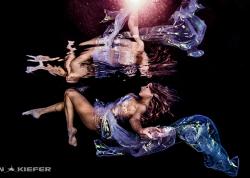Take Your Photography to the Next Level
Take Your Photography to the Next Level
3 Essential Camera Settings for Shooting Underwater
Text and Photos By Brent Durand

Underwater photography is an activity where the learning never stops. It’s a daunting task to begin understanding camera and shooting basics, and those that stick with it will learn to apply the skills needed to capture underwater photos. But what’s next on the learning curve once you reach this first plateau? How do we progress from taking snapshots to creating images that convey our feelings when viewing a reefscape, depicting subtle marine life behavior or creating abstract art?
Different photographers will have different interests, leading them to focus on any number of specialties in u/w photography. Regardless of where these specialties take you, all will require a more advanced understanding of your camera and how use of specific features can help capture the perfect shot. Below are three of those advanced setting tips.
Shoot in Manual Mode
Precise creative control is achieved by limiting variables. We eliminate these variables by manually controlling our exposure, depth of field and other settings. This is done by setting the camera's shutter speed, aperture and ISO. Once you start shooting in manual it will become second nature.
That said, there are two notable exceptions. The first is using auto white balance. DSLR, Mirrorless and many new compact cameras have very good auto white balance capabilities when using strobes. Some subjects will throw it off, but if you’re shooting in RAW you will be able to compensate with small adjustments during post processing. The second exception to the manual rule is using TTL strobe exposure. Your camera settings will determine the ambient light entering the camera and the depth of field – you always want full control here. By using TTL with your strobes, you’re letting the camera choose strobe power and exposure of the scene (macro) or exposure of the primary subject/foreground (wide-angle). TTL is very good these days and getting more accurate, especially for shooting macro.


A manatee looks beyond my dome port in ambient light.
Use Your Histogram
How do you know if you’re capturing a proper exposure? It’s dark underwater and the camera’s LCD screen can be deceptive, making images appear brighter than they actually are. A great example is when your mobile phone screen dims in low light. You can see it well in the dark but if you took it into regular/bright light the screen would be too dark to see.
The true measure of brightness is indicated in the histogram, which is easily accessed by pushing the Info button when reviewing images. If the curve of the histogram stacks against the right side, your photo is overexposed. If the curve stacks against the left side, your photo is underexposed. An ideal exposure lies in between these white and black points.
The more you use the histogram the more you'll be able to recognize contrast and dynamic range in a scene. Advanced shooters take these factors into consideration before firing a single shot, and there's no better way to begin "seeing" these qualities than learning from the histrogram as you shoot and edit images.

Black water contrasts white sea pen polyps as a porcelain crab looks out into the water column.

A sea lion pup eager to continue playing inside a cavern at Los Islotes.
Select your Autofocus Point
Most advanced compacts and all mirrorless and DSLR cameras will let you select between autofocus points. Every photographer has images that are well composed and exposed but simply lack focus on the important part of the scene: eyes, rhinophores, foreground subject, etc.
Your camera often can’t recognize these important focal points (whether shooting photo or video) when using the general autofocus zones, so you need to tell it where to focus using two steps. First, select a single autofocus point or a tight group of points. Second, move that focus point to the important part of the frame. This will guarantee sharp focus on the important part of the scene whether shooting 1 or 10 images of the subject, and is often easier than the “focus and recompose” method using AF-Lock.

A connection with this network pipefish is established through a combination of sharp focus on the eyes and shallow depth of field.

Scorpionfish portrait.
Conclusion
An intimate knowledge of your camera and the best underwater photography settings is essential for capturing great images. By utilizing the three settings above you’ll by ready to take your photography to the next level. All that's left is to practice, practice, practice.
About the Author
 Brent Durand is a weekend wanderer, story teller and image maker from California. Follow UWPG on Facebook for daily photos, tips & everything underwater photography.
Brent Durand is a weekend wanderer, story teller and image maker from California. Follow UWPG on Facebook for daily photos, tips & everything underwater photography.
Further Reading
-
Mating Blue-Ringed Octopus: Story Behind the Photos
-
Underwater Strobe Positioning Guide
-
Composition Tips for Underwater Photography
Where to Buy
Please support the Underwater Photography Guide by purchasing your underwater photography gear through our sister site, Bluewater Photo & Video. Click, or call them at (310) 633-5052 for expert advice!
RECOMMENDED ARTICLES
SUPPORT THE UNDERWATER PHOTOGRAPHY GUIDE:
The Best Service & Prices on u/w Photo Gear
 Visit Bluewater Photo & Video for all your underwater photography and video gear. Click, or call the team at (310) 633-5052 for expert advice!
Visit Bluewater Photo & Video for all your underwater photography and video gear. Click, or call the team at (310) 633-5052 for expert advice!
The Best Pricing, Service & Expert Advice to Book your Dive Trips
 Bluewater Travel is your full-service scuba travel agency. Let our expert advisers plan and book your next dive vacation. Run by divers, for divers.
Bluewater Travel is your full-service scuba travel agency. Let our expert advisers plan and book your next dive vacation. Run by divers, for divers.






























